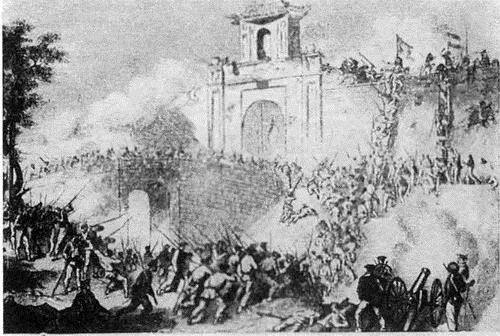Gia Định Citadel-Collapsed in a blink of an eye

Phiên An Citadel: A Symbolic Military Stronghold
Origins and Design
Phiên An Citadel, also known as the Octagonal Citadel (Thành Bát Quái) or Thành Quy, was commissioned by Emperor Gia Long and built in Sài Gòn on February 4, 1790. It was designed using a blend of Eastern and Western military architecture, based on blueprints by the French military engineer Olivier de Puymanel (known in Vietnamese as Ông Tín). The citadel had eight sides, which gave rise to the name "Bát Quái" (Eight Trigrams).
Location and Structure
- The citadel's center corresponds to the current location of Notre-Dame Cathedral Basilica of Saigon.
- Its gates extended across what are now Bình Thạnh, District 10, and District 5.
- One gate still remains today, located on Phan Đăng Lưu Street in Bình Thạnh District.
The citadel was constructed during the time when Gia Long was being pursued by Tây Sơn forces. Fortunately, the Tây Sơn army was then focused on northern campaigns against the Han invaders, allowing construction to proceed without interruption.
Advanced Construction Techniques
- The citadel was built following the modern Vauban-style fortress model from France, but adapted into an octagonal shape, reflecting East Asian aesthetics.
- The outer walls stood 4.8 meters high and were built using Biên Hòa laterite stone—a material that is soft underground but hardens significantly over time when exposed to air.
A Complex Multi-Layered Defense System
Phiên An featured a layered defensive layout:
- An outer wall made of earth, and an inner wall made of stone.
- Moats were constructed around the perimeter, forming multiple lines of defense.
- If one section was breached, defenders could retreat to the inner layers and continue to resist.
This fortified design was so formidable that it discouraged not only the Tây Sơn forces, but even Nguyễn imperial troops who had to dig deep trenches to approach it during the campaign to capture Lê Văn Khôi. The main gate was effectively impervious to direct assault.
Emperor Minh Mạng’s Decision to Demolish Phiên An
The extreme durability of Phiên An—combined with the strategic nightmare it posed during the Lê Văn Khôi rebellion—prompted Emperor Minh Mạng to order its complete demolition. In its place, he constructed a new citadel nearby: Phụng Citadel, which featured:
- Smaller dimensions
- A simple square shape
- Virtually no heavy fortifications
This decision was strategic in nature—intended to prevent future rebel groups from using a fortified stronghold as a base of resistance, as had happened with Phiên An.
Image 1 :A pedestrian entrance of Phiên An Citadel (not the main gate used for horses and carriages)

The Fall of Gia Định Citadel in 1859: When Fortifications No Longer Held
The Franco-Spanish Invasion of Southern Vietnam
After their initial advances in Central Vietnam, such as Quảng Nam and Đà Nẵng, the French forces, together with their Spanish and Filipino allies, turned their sights to the South.
On February 11, 1859, around 2,000 troops—including 450 Filipino soldiers—and eight warships entered the Cần Giờ River, only to be met by fierce resistance from dozens of small Vietnamese outposts. Despite each outpost holding just a few dozen to 100 men, their determination delayed the invasion for nearly five days.
The Battle at the Gates of Gia Định
By the evening of February 15, two major defensive forts at the eastern gateway of Gia Định—Vàm Cỏ and Cá Trê (now around the Thủ Thiêm Tunnel area)—engaged the invading fleet.
According to The Cultural Gazetteer of Ho Chi Minh City, the Vàm Cỏ Fort, known formally as Ụ Hữu Bình, stood near the junction of the Sài Gòn River and Tân Thuận Bridge. Vietnamese forces had prepared a fire ship attack using wooden boats loaded with straw and gunpowder. However, the fleet detected and preemptively destroyed them before impact.
The fierce bombardment lasted through the night, with the forts only falling by midday February 16.
Gia Dinh Citadel Falls
Following the river, the Franco-Spanish forces advanced along the Boulevard Citadel (now Tôn Đức Thắng Street), breaching the southeastern main gate of Gia Định Citadel—now the intersection of Lê Duẩn and Đinh Tiên Hoàng.
By midday on February 17, 1859, Gia Định Citadel fell.
What If the Original Phiên An Citadel Had Survived?
A Historian’s Hypothesis
Many historians speculate that if the original Phiên An Citadel, with its formidable Vauban-style fortifications, had not been demolished:
- It could have held out long enough for reinforcements from other southern provinces (Lục Tỉnh Nam Kỳ) to arrive.
- The Franco-Spanish forces may not have risked sending only 2,000 troops, knowing the defensive strength of the old citadel.
- The course of Vietnamese history might have turned out very differently.
But History Does Not Recognize "What If"
Yet, history unfolded as it did. The new Phụng Citadel, built by Emperor Minh Mạng after the destruction of Phiên An, was smaller, simpler, and lacked strategic resilience.
It was unable to withstand a serious siege, and with its fall in 1859, Sài Gòn entered the colonial era under French control.
Indeed, no one can ever truly know what might have been.
Image 2 :The Franco-Spanish alliance attacked Gia Định Citadel on February 17, 1859 – A French illustration depicting the battle. The image shows the assault on the main gate of the citadel, with the frontal facade corresponding to today’s Lê Duẩn Street – Archival image.



